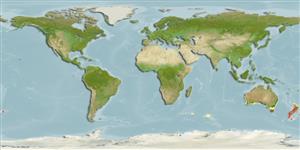Common names from other countries
Environment: milieu / climate zone / depth range / distribution range
Ekologi
marina bottenlevande; djupintervall 22 - 222 m (Ref. 58489), usually ? - 100 m (Ref. 30464). Temperate
Southwest Pacific: in temperate waters.
Size / Vikt / Age
Maturity: Lm ? range ? - ? cm
Max length : 35.0 cm TL hane/ej könsbestämd; (Ref. 30464); common length : 20.0 cm TL hane/ej könsbestämd; (Ref. 30464)
Occur in the continental shelf (Ref. 7300, 75154). Benthic (Ref. 75154). Sedentary fishes that swim slowly and spend much of their time resting on the bottom. They use the long snout for probing in crevices, seaweed and sand for crabs, worms, and other benthic invertebrates (Ref. 30464). Neither anterolateral glandural groove nor venom gland is present (Ref. 57406).
Life cycle and mating behavior
Könsmognad | Reproduktion | Lek | Ägg | Fecundity | Larver
Paxton, J.R., D.F. Hoese, G.R. Allen and J.E. Hanley, 1989. Pisces. Petromyzontidae to Carangidae. Zoological Catalogue of Australia, Vol. 7. Australian Government Publishing Service, Canberra, 665 p. (Ref. 7300)
IUCN Red List Status (Ref. 130435)
CITES (Ref. 128078)
Not Evaluated
Threat to humans
Harmless
Human uses
Fiskeri: saknar intresse
Ytterligare information
PopulärnamnsynonymerMetabolikPredatorerEkotoxikologiReproduktionKönsmognadLekFecundityÄggEgg development
Age/Size
Tillväxt
Length-weight
Length-length
Length-frequencies
Morfometri
Morfologi
Larver
Larvdynamik
Rekrytering
Abundans
referenserVattenbrukVattenbruksprofilAvelslinjerGenetikElectrophoresesÄrftlighetSjukdomarBehandlingMass conversion
MedarbetareBilderStamps, Coins Misc.LjudCiguateraHastighetSimsättGälytaOtolithsHjärnstorlekSyn
Verktyg
Special reports
Download XML
Internet-källor
Estimates based on models
Preferred temperature (Ref.
115969): 10 - 18.1, mean 15.1 (based on 157 cells).
Phylogenetic diversity index (Ref.
82804): PD
50 = 0.5176 [Uniqueness, from 0.5 = low to 2.0 = high].
Bayesian length-weight: a=0.01000 (0.00244 - 0.04107), b=3.04 (2.81 - 3.27), in cm Total Length, based on all LWR estimates for this body shape (Ref.
93245).
Trofisk nivå (Ref.
69278): 3.8 ±0.5 se; based on size and trophs of closest relatives
Fishing Vulnerability (Ref.
59153): Low vulnerability (25 of 100).
